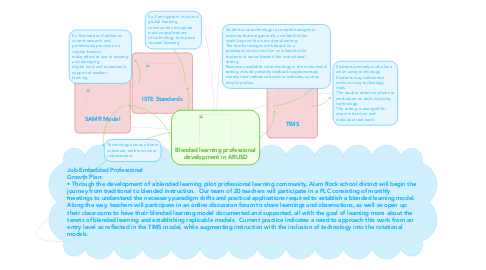Blended learning professional development in ARUSD
by Jason Sorich

1. ISTE Standards
2. 5c. Evaluate and reflect on current research and professional practice on a regular basis to make effective use of existing and emerging digital tools and resources in support of student learning
3. 5a. Participate in local and global learning communities to explore creative applications of technology to improve student learning
4. SAMR Model
5. Technology acts as a direct substitute, with functional improvement
6. Job-Embedded Professional Growth Plan: • Through the development of a blended learning pilot professional learning community, Alum Rock school district will begin the journey from traditional to blended instruction. Our team of 20 teachers will participate in a PLC consisting of monthly meetings to understand the necessary paradigm shifts and practical applications required to establish a blended learning model. Along the way, teachers will participate in an online discussion forum to share learnings and observations, as well as open up their classrooms to have their blended learning model documented and supported, all with the goal of learning more about the tenets of blended learning and establishing replicable models. Current practice indicates a need to approach this work from an entry level as reflected in the TIMS model, while augmenting instruction with the inclusion of technology into the rotational models.
7. TIMS
8. Students primarily work alone when using technology. Students may collaborate without using technology tools. The teacher directs students to work alone on tasks involving technology. The setting is arranged for direct instruction and individual seat work.
9. Students use technology to complete assigned activities that are generally unrelated to the world beyond the instructional setting. The teacher assigns work based on a predetermined curriculum unrelated to the students or issues beyond the instructional setting. Resources available via technology in the instructional setting include primarily textbook supplementary material and reference books or websites, such as encyclopedias.


